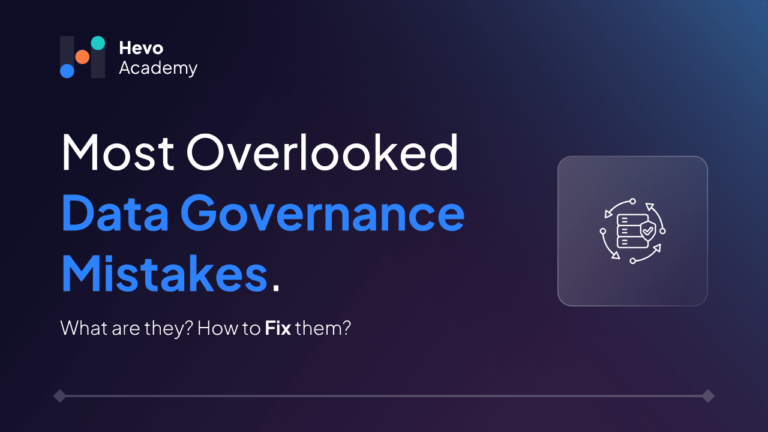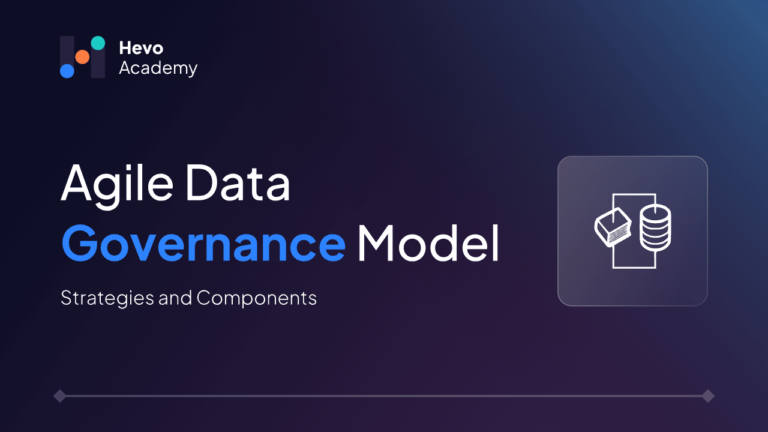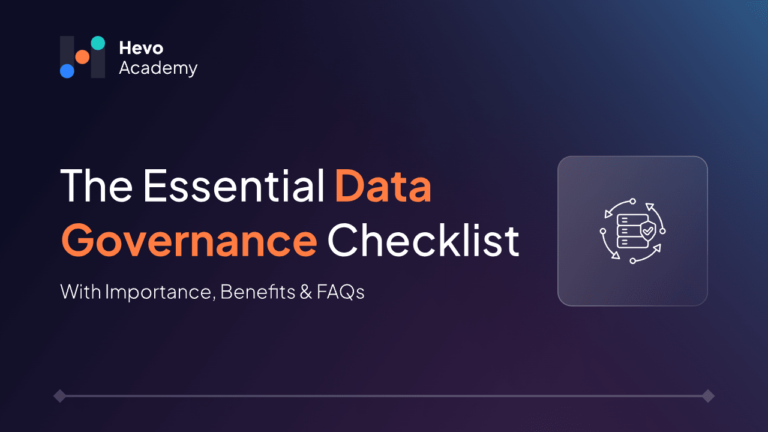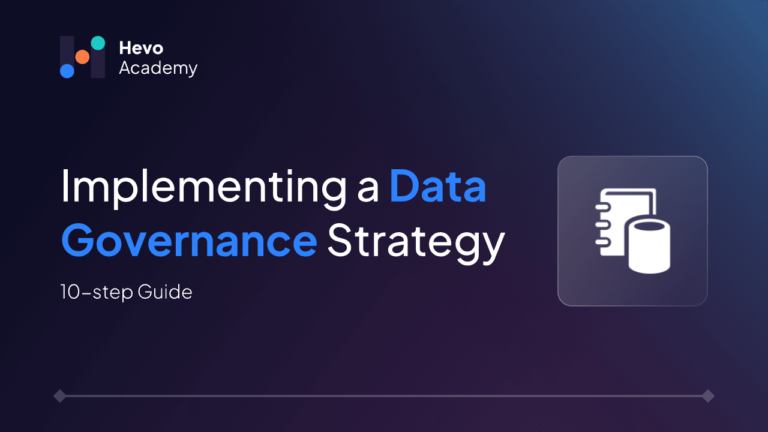Effective data governance is the cornerstone of gaining insight, maintaining compliance, and making better business decisions. However, many organizations fail to do so because of common mistakes in implementing data governance. This article will outline the common data governance mistakes and strategies to avoid them so that organizations can optimize their data governance strategies and practices.
Table of Contents
What is Data Governance?
Data Governance is the framework and set of processes to ensure the availability, security, integrity, and accessibility of data assets. It includes well-defined policies, guidelines, and rules governing data quality, data management, and data privacy.
Why is Data Governance Critical?
Data Governance is important for business organizations since it enables establishing confidence in data, helping a company improve its decisions, reduce risks, and consequently increase its business efficiency.
Hevo’s no-code data integration platform helps you sidestep common data governance errors and stay in control of your data.
Here’s how Hevo can help:
- Data Quality at the Core: Poor data quality is a major governance issue. Hevo automates quality checks at every stage, ensuring accurate, consistent, and reliable data.
- Centralized Data Management: Avoid scattered data silos by integrating all your data sources in one platform. Hevo provides a single, unified view of your data, making governance easier to implement and monitor.
- Automated Data Lineage: Track data flow from source to destination with Hevo’s built-in data lineage features. This helps you maintain transparency and accountability, reducing governance risks.
Don’t let common data governance mistakes derail your operations. With Hevo, you can improve data quality, and ensure compliance—all with a few clicks.
Get Started with Hevo for FreeCommon Data Governance Mistakes and How to Resolve Them
Mistake 1: Lack of clear goals and objectives
One common mistake organizations make is not having clearly defined goals and objectives for data governance initiatives. Without a clear roadmap for data governance, organizations may struggle to align the business goals and not achieve the desired outcomes. Hence, it is crucial to set measurable goals and align them with the business process to achieve the desired outcome.
Solution: Setting clear and measurable goals
Start defining clear and measurable goals for data governance initiatives. These goals should align with organizations’ overall business objectives and be concrete, measurable, achievable, and time-bound. Regularly track progress and assess it to ensure continuous improvements.
Mistake 2: Inadequate Data Quality Measurement
Data quality is the key element of Data Governance. Organizations often neglect the data quality measures, resulting in unreliable and inconsistent data.
Solution: Implement robust quality controls
Measure data quality and ensure that the data used for decision-making is accurate and reliable. Implement data profiling to identify data quality issues, a validation process to ensure data integrity, and monitoring to maintain data quality.
Mistake 3: Insufficient stakeholder engagement
Again, this is a common pitfall in implementing data governance in organizations. Without regular involvement of stakeholders from all levels, data governance initiatives may face problems and lack the needed support to succeed.
Solution: Engage Stakeholders
Engage stakeholders from all levels to ensure proper data governance implementation. Take their input, address their concerns, and make them part of decision-making. Take a collaborative approach to get the necessary support and expertise for building data governance.
Mistake 4: Neglecting Data Security and Privacy
Data breaches and privacy concerns have increased in recent years. Neglecting data security and privacy measures puts organizations at risk of legal consequences, reputational damage, potential costume loss, or loss of customer trust. Implementing data encryption, access policies, and privacy policies lowers the risk and ensures sensitive data protection.
Solution: Prioritize Data Security and Privacy
Make data security and privacy a top priority. Implement data encryption and access control policies. Additionally, ensure compliance with relevant data privacy regulations, such as CCPA or GDPR, to protect customer data and gain trust.
Mistake 5: Data illiteracy
Every company that does not pay attention to the fact that its employees may not be data literate fails to harness the potential of this tool. Data literacy helps employees understand how to analyze and use data properly. By addressing data literacy among the workforce or through numerous training and education, organizations will ensure proper decision-making.
Solution: Promote Data Literacy Among Employees
Promote the enhancement of data literacy among employees, to enable them to comprehend the data, analyze it, and incorporate the information in their activities. Employer training, providing data and data visualization tools to the employees, and encouraging the use of data. Following a step further, creating a data-literate culture optimizes organizational decision-making and the value realized from its data resources.
Mistake 6: Failure to adopt changes
In today’s business world, where change is becoming almost a rule rather than an exception, a lack of change can be a detriment to good data governance. Thus, several relevant technologies and regulations may require changes over several years, so organizations should be timely in their approach toward data governance. That way, data governance remains relevant, efficient, and on par with the organizational objectives in the face of change.
Solution: Embrace Change in Data Governance
Last, reward and embrace change in your organization. Accept new technologies, changes in legislation, and new trends in business processes. This means making it a routine to evaluate data governance and make necessary changes when necessary to be competent in the modern data environment.
Best Practices for Data Governance
Each organization’s data governance framework can be different based on their need but here are the common principles represented as best practices for data governance.
Lead with why?
Understand the need for data governance.
Something that makes sense for starting with your “why” and engaging your people is how data governance has developed over the years.
Data governance should be a virtual, non-commercial, and community-based practice. In such an environment, it is done by everyone in your organization, not just an individual.
Thus, employees must understand why your data governance program, policies, and standards must be in place. Begin by asking your teams how they envision your organization’s data culture in the next year and a half.
Develop a data product Mindset
This practice relates to data governance: the transition from a data service-oriented approach to a data “product”-oriented approach.
A data product is any object that provides value through capabilities related to data, such as translating the data and giving insights. It may be raw data, warehouses, KPI, domain data, algorithms, and whatnot.
Product thinking, when applied to data, can help make sense of data at scale. Unlike a service, you form the product, and many users can leverage it to solve a particular challenge. Product thinking enables you to revisit the product and figure out how to make more value for your customer. But the concept is still the same: understand what your customers want and then deliver it to them.
Embedded collaboration
One of the fundamental aims of data governance is to make an organization’s data readily usable, interpretable, and consumable. Metadata is instrumental in this outcome as it provides consumers with the necessary context to find and understand data.
Embedded collaboration is about work and fundamental activity occurring where you are with the least possible resistance.
With embedded collaboration, several questions regarding the history and source of specific information can be answered, which in turn contributes to making data management even easier.
You can help your key stakeholders adopt new metadata practices by integrating them into their daily data-sharing and discussion activities. For example, instead of leaving Looker, they could find the data definitions with Slack or check the lineage.
Every data analyst or person trying to understand a dataset can do it with his preferred BI tool. Everyone can obtain all the context about that asset, including the specific definition from the glossary, discussions in Slack, questions, data mapping, and others.
Many companies adopt agile data governance to address traditional governance challenges, but it’s important to adapt this model carefully to avoid potential pitfalls.
Automate wherever possible
Automation in data governance eliminates time-consuming, non-scalable, and error-prone processes that are difficult to scale. To meet today’s very rigorous data demands, that is the only way data governance can be scaled.
Implement DataOps
Consequently, it applies the principles of lean manufacturing, Agile methodology, and DevOps to data. So, DataOps ensures that you: So, DataOps ensures that you:
- Build your data product to meet the value to the end-user and the business.
- Treat “data products” as “software products” utilizing the concepts of Agile and automation (CI/CD pipelines).
- Integrate data governance into the threads of daily working of all people in your company
Invest in the Right Tools and Technology
Therefore, the tool you must employ for data governance across your organization must have these characteristics.
To ensure you have a solution that lets you embrace data governance best practices, your chosen tool/platform should have the following capabilities:
- Searchable data catalogs
- Customized data workspaces
- Granular and role-based access controls
- Automation tooling
- Data quality profiling
Top Data Governance Tools
- Collibra Data Governance
- SAP Master Data Governance (MDG)
- OvalEdge
- Atlan
- Apache Atlas
- Precisely: Data360 Govern
- OneTrust Data Governance
- Erwin Data Intelligence
Conclusion
To avoid common pitfalls and ensure success in data governance, it’s important to set clear objectives, maintain data quality, engage stakeholders, prioritize data security, foster data literacy, and be change-oriented. As if that were not enough, other techniques for best practices would add weight to an organization’s ability to manage and leverage data assets. The right strategies and proper tools and practices in hand make effective data governance possible. This way it would allow any organization to make good decisions, maintain compliance, and hopefully improve efficiency overall, as organizations go data-driven. Sign Up with Hevo for a 14-days Free Trial.
FAQs
1. Why does data governance usually fail?
Data governance often fails due to indistinct objectives, non-involvement of stakeholders, inadequate measures on data quality, or paying less heed to security and privacy issues. An inability to stay abreast of emerging technologies, regulations, or changing needs of an organization will contribute to governance breakdowns. More successful governance initiatives are seen in structured frameworks, well-defined goals, and collective efforts.
2. What was the greatest challenge you had in data governance?
The biggest challenge faced is stakeholder engagement throughout the organization. More often than not, data governance is viewed as some form of technical problem when, by far, business and technology teams must get together. Furthermore, managing data quality and keeping current with regulatory changes can be particularly tricky.
3. What are some of the consequences of bad data governance?
Poor data governance can lead to a host of issues, such as wrong data, legal and compliance risks, breaches of personal data, loss of customer trust, inefficient business processes, and missed opportunities for the business. It may also lead to expensive mistakes, inconsistent decision-making, and reputational damage.
4. What’s an example of a governance failure?
The 2017 Equifax data breach is a good example of governance failure since proper security measures and governance policies could have prevented the risk to more than 140 million people’s information. This lack of data protection brought legal consequences, financial loss, and extensive reputation damage. This clearly shows the importance accorded to data security and privacy through a data governance framework.





